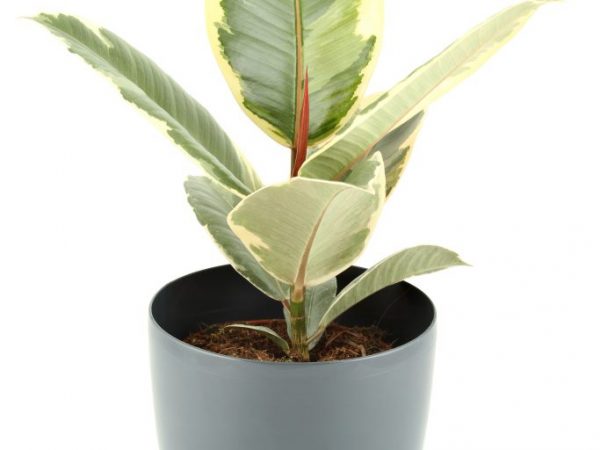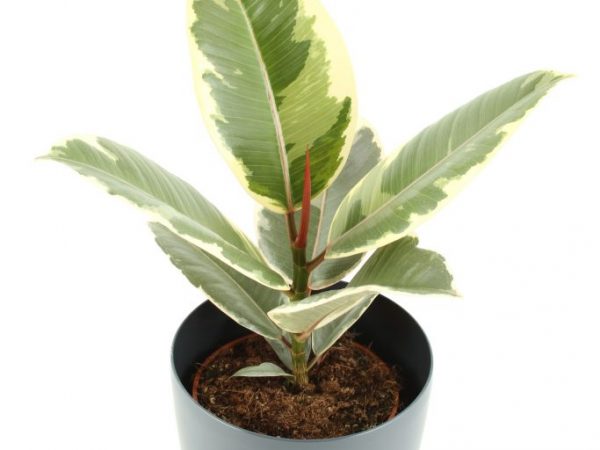How to care for Tineke ficus at home
Ficus is especially popular among domestic plants. Its healing qualities are often used in everyday life, and signs claim that the flower brings prosperity and peace to the family. In addition, Tineke ficus is an excellent design element.

How to care for Tineke ficus at home
He needs minimal care, and the crown of the plant can be formed in the form of a sculpture, and the variegated colors of some varieties can dilute the interior of the room with paints. The latter includes such a plant species as Tineke ficus. The border of its foliage has a bright light color, which attracts many designers.
Description of the variety of ficus Tineke
Ficus Elastica Tineke is a member of the mulberry family.
This rubbery ficus can grow to large sizes. In natural conditions, the flower grows in the north of India and Indonesia. The leaves of the plant are large, oval in shape. Under natural conditions, the size of the sheet can range from twenty to thirty centimeters. The color of the crown is variegated, it combines a rich green color and a white border. There are diagonal white stripes along the veins.
Very often in the wild, the branches of a plant can take root and form new trunks. Thus, Tineke ficus is able to grow to a whole grove. At home, the plant began to grow in the middle of the nineteenth century. The flower came to the taste of ordinary people, since it requires little attention to itself and cleans the air well. For the beauty of the foliage, a photo of this ficus variety is often adorned with plant atlases.
Tineke ficus care
Ficus Tineke, like other representatives of this variety of indoor flowers, does not require a lot of attention.
The plant is unpretentious at home and is suitable for novice florists. Among the difficulties that flower owners may face, only the rapid growth and sensitivity of the leaves to light can be distinguished.
However, for good growth and brightness of colors, it is still worth paying attention to factors such as:
- lighting in the room;
- temperature in the house;
- watering mode;
- lure;
Indoor light with Tineke ficus
Light for this type of flower is of particular importance. If the plant is in a darkened part of the room, then the ficus leaf begins to lose its variegated color and become just green. Also, when the process of photosynthesis slows down, the tree begins to actively shed its crown and falls into a state of dormancy.
The tineke ficus should be kept close to the window. In summer, the flower can be taken out into the garden or on the loggia, however, beware of direct sunlight. Ultraviolet light can leave deep burns on the foliage of the flower, so the location should be chosen with the expectation that the plant will be in the shade at noon.
Air temperature
The natural climatic conditions for ficus are warm countries, so the plant does not tolerate cold well.The temperature in the room should not drop below five degrees. In this case, the leaves and stem of the flower begin to blacken, and the bush may die.
High temperatures can harm the ficus tree if the air in the room is too dry. Under natural conditions, the tree easily tolerates heat due to high humidity.
Watering mode

You need to follow the watering schedule
Ficus Tineke is good for wet soil, unlike many other varieties of this plant. The soil of the flower should not dry out, as this leads to the death of the root system. But it is forbidden to fill the bush - the roots immediately begin to rot.
The ficus watering regime depends on the season and climatic conditions. The soil moisture schedule looks like this:
- In the summer, the plant is watered three times a week.
- In winter and autumn, watering should be reduced to two or even once a week.
- In the spring, the leaves begin to grow actively, so at this time the plant should be watered as needed. You can also dilute special vitamins and minerals in water.
Only settled water is used for irrigation - the ficus does not tolerate bleach well and can die from a similar component in the liquid. For Tineke ficus, a drip irrigation system is also suitable.
Humidity level in the room
Ficus Tineke does not tolerate dry air. In the natural habitat, the plant has a high level of humidity. Dry air can cause yellowing and shedding of foliage.
Most often this happens with indoor flowers, which are located near the battery during the heating season. To keep the ficus from drying out, spray the foliage and stem of the plant several times a week. Spray water must be boiled.
Also, a pallet with expanded clay will help to cope with this problem. The base is poured with water, and a pot is placed on top. Expanded clay will slowly release moisture, thereby saturating the plant. This method requires practically no energy costs, because you need to add water to the sump only once a week.
Crown pruning
Ficus Tineke is famous for its fast growth and wide foliage. If you do not take care of the plant and do not cut the top in time, then the flower can grow to the ceiling. The flower should be cut for sanitary purposes at least three times a year. Dry leaves and old shoots are removed during this trimming. If necessary, prune healthy shoots that are spreading along the ground. Such outgrowths can take root, which will lead to the appearance of another center stem. In this case, the tub can become cramped for the flower.
Ficus Tineke is also suitable for crown formation. To get a decorative figure from a plant, you should plant several cuttings in one pot and prune them during the warm season. After a while, the ficuses will form a bush, which will be a good decoration for your home.
Flower feeding
Like any living organism, Ficus elastica tineke cannot exist without a complex of vitamins and minerals. First of all, the plant needs components such as nitrogen and magnesium. The first is responsible for the accelerated growth of foliage, and the second protects the crown from aging. As a top dressing, you can use the Emerald fertilizer, which combines both elements.
Follow directions and proportions when fertilizing the flower. Excessive feeding can seriously injure the roots of the plant.
Reproduction of ficus
This plant is very easy to breed at home using vegetative propagation. A shoot with a couple of leaves is cut off from the ficus, after which it is kept in water for some time. As soon as the cutting takes root, it can be transplanted into a tub. Do not plant more than five shoots in one pot.
Ficus Tineke grows quickly enough, which is why the root system of different seedlings can intertwine and begin to die. Caring for young ficuses differs only in frequent transplantation - it should be done annually.
Plant transplant
Ficus, like any houseplant, should be transplanted. Flower soil contains special trace elements, but over time, the plant draws out useful components and even fertilizer cannot replace them.
The number of transplants depends on the age of the plant. Young ficuses should be replanted every year, and a flower that is more than five years old can remain in one pot for a long time. The shallowness of the leaf and the degeneration of the shoots serve as a signal for the need to change the land.
To transplant ficus, a new pot is poured over with boiling water, after which it is thoroughly dried. Drainage spreads to the bottom, which can consist of the following materials:
- broken brick;
- shards of pottery;
- expanded clay.
New soil is poured next. The soil for flowers should combine many useful elements. The ideal soil for ficus looks like this:
- sand;
- leafy land;
- peat.
After transplanting, the flower should be fertilized and watered. After a while, the leaves of the ficus may turn yellow due to stress, but after two weeks the plant will return to normal.
Diseases and pests
The causes of ficus disease can be many. Most often, the flower affects the disease if the sanitary conditions of detention are not observed. The plant cannot be kept in a draft and often rearranged from one place to another.
The wrong watering regime can also lead to yellowing and foliage falling off.
But if the care of the plant is of high quality, and the ficus continues to die, then harmful insects may be the cause.
The most common pests among indoor flowers are:
- Shield. This insect drinks juice from plant leaves, piercing them with a sharp trunk. The foliage of the infected flower is covered with raised spots on the outer surface. The pest is destroyed with Actellik and soap solution.
- Mealybug. This parasite is most often found on the leaves of the tineke ficus. Its characteristic feature is the cobweb knotted into lumps in which this insect lives. The worm also feeds on sap and greatly slows down the development of the flower. To get rid of this parasite, you should clean the cobwebs from the leaves with soapy water and spray the plant with a confidant preparation.
- Aphid. The active period of infection of plants with these pests falls on summer and spring. The insect settles in colonies on the inner surface of the leaf. In the fight against aphids, you should wipe every centimeter of foliage with soapy water and perut.


